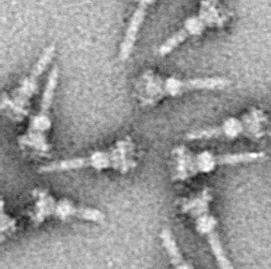Type III secretion system
A protein appendage found in several Gram-negative bacteria
The Type III secretion system (T3SS) is a complex protein appendage found in several Gram-negative bacteria. It is used by these bacteria to inject effector proteins directly into eukaryotic cells, which can manipulate host cell functions to the advantage of the bacteria. The T3SS is structurally similar to the flagellum, and it is believed that both systems evolved from a common ancestor.
Structure[edit | edit source]
The T3SS is composed of several components that form a needle-like structure. This structure is often referred to as the "needle complex" and is responsible for the translocation of proteins across the bacterial and host cell membranes.
Needle Complex[edit | edit source]
The needle complex is a multi-protein assembly that spans the bacterial inner and outer membranes. It consists of a basal body, a needle, and a translocon. The basal body anchors the needle complex to the bacterial membranes, while the needle protrudes from the bacterial surface and penetrates the host cell membrane.
Basal Body[edit | edit source]
The basal body is a cylindrical structure that provides the foundation for the needle complex. It is composed of several rings that are embedded in the bacterial membranes. The basal body is similar in structure to the basal body of the bacterial flagellum.
Needle[edit | edit source]
The needle is a hollow tube that extends from the basal body. It is composed of polymerized proteins that form a rigid structure capable of penetrating host cell membranes.
Translocon[edit | edit source]
The translocon is a protein complex that forms a pore in the host cell membrane, allowing effector proteins to be delivered directly into the host cell cytoplasm.
Function[edit | edit source]
The primary function of the T3SS is to deliver effector proteins into host cells. These effector proteins can alter host cell processes, such as cytoskeleton dynamics, immune response, and cell signaling, to facilitate bacterial infection and survival.
Evolution[edit | edit source]
The T3SS is believed to have evolved from the bacterial flagellum, as both systems share structural similarities and components. This evolutionary relationship suggests that the T3SS and flagellum may have originated from a common ancestral secretion system.
Related pages[edit | edit source]
Search WikiMD
Ad.Tired of being Overweight? Try W8MD's physician weight loss program.
Semaglutide (Ozempic / Wegovy and Tirzepatide (Mounjaro / Zepbound) available.
Advertise on WikiMD
|
WikiMD's Wellness Encyclopedia |
| Let Food Be Thy Medicine Medicine Thy Food - Hippocrates |
Translate this page: - East Asian
中文,
日本,
한국어,
South Asian
हिन्दी,
தமிழ்,
తెలుగు,
Urdu,
ಕನ್ನಡ,
Southeast Asian
Indonesian,
Vietnamese,
Thai,
မြန်မာဘာသာ,
বাংলা
European
español,
Deutsch,
français,
Greek,
português do Brasil,
polski,
română,
русский,
Nederlands,
norsk,
svenska,
suomi,
Italian
Middle Eastern & African
عربى,
Turkish,
Persian,
Hebrew,
Afrikaans,
isiZulu,
Kiswahili,
Other
Bulgarian,
Hungarian,
Czech,
Swedish,
മലയാളം,
मराठी,
ਪੰਜਾਬੀ,
ગુજરાતી,
Portuguese,
Ukrainian
Medical Disclaimer: WikiMD is not a substitute for professional medical advice. The information on WikiMD is provided as an information resource only, may be incorrect, outdated or misleading, and is not to be used or relied on for any diagnostic or treatment purposes. Please consult your health care provider before making any healthcare decisions or for guidance about a specific medical condition. WikiMD expressly disclaims responsibility, and shall have no liability, for any damages, loss, injury, or liability whatsoever suffered as a result of your reliance on the information contained in this site. By visiting this site you agree to the foregoing terms and conditions, which may from time to time be changed or supplemented by WikiMD. If you do not agree to the foregoing terms and conditions, you should not enter or use this site. See full disclaimer.
Credits:Most images are courtesy of Wikimedia commons, and templates, categories Wikipedia, licensed under CC BY SA or similar.
Contributors: Prab R. Tumpati, MD




